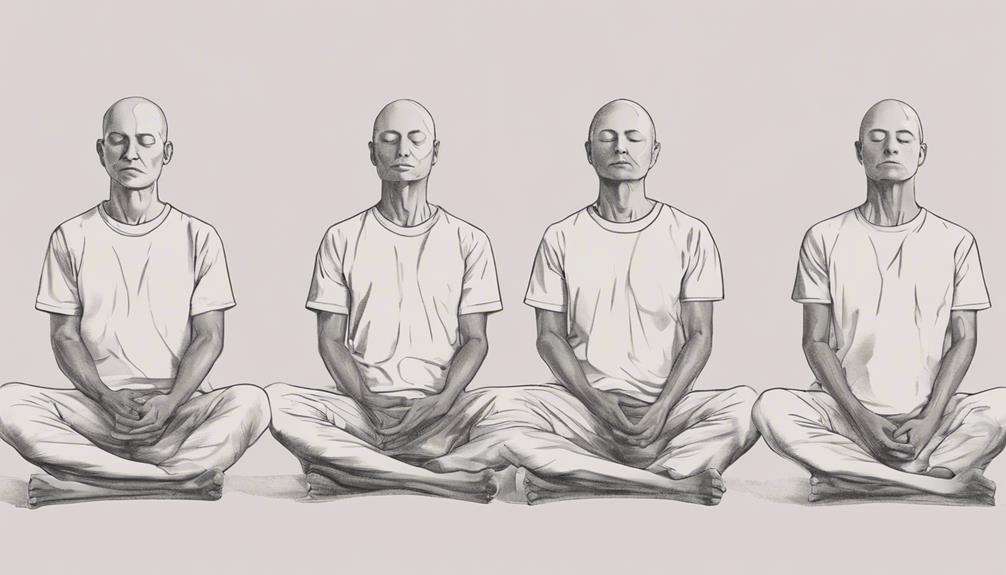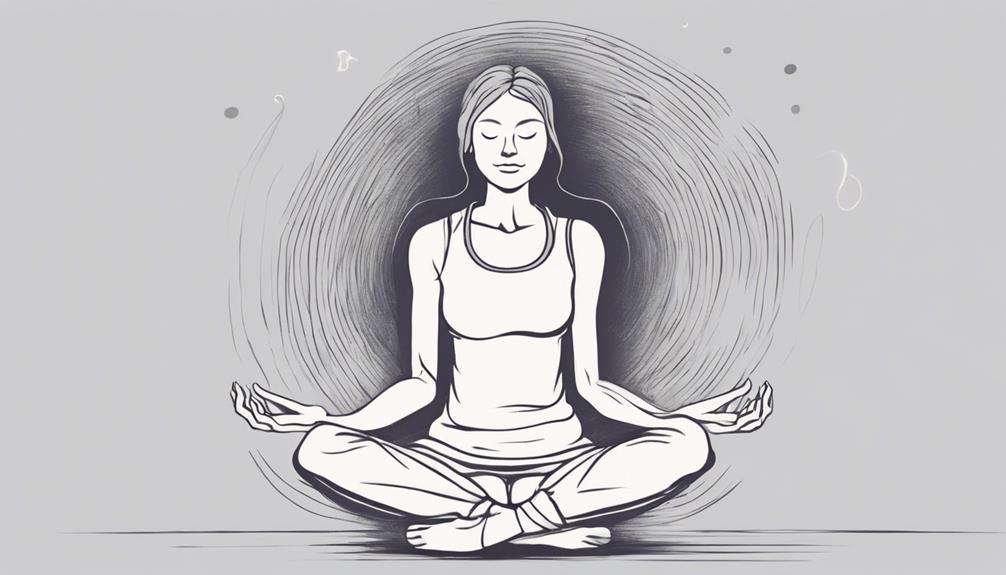When it comes to managing chronic pain, have you ever considered the power of mindfulness meditation techniques?
The art of tuning into the present moment might hold the key to transforming your experience of pain. Through a range of mindfulness practices, individuals have discovered a newfound sense of control and relief.
But how exactly can these techniques help you navigate the complexities of chronic pain? Let's explore the possibilities together.
Key Takeaways
- Mindfulness meditation reshapes brain structures for enhanced pain thresholds.
- Emotional regulation through mindfulness reduces stress and anxiety linked to chronic pain.
- Techniques like mindful breathing and body scan aid in effective pain management.
- Mindfulness offers nonpharmacological tools for navigating complexities of chronic pain.
Understanding Mindfulness Meditation for Pain Management
To effectively manage chronic pain, understanding the principles and techniques of mindfulness meditation is essential. Chronic pain patients often face immense challenges that impact their daily lives, both physically and emotionally. Mindfulness meditation offers a valuable tool in pain management by encouraging individuals to cultivate non-elaborative, non-judgmental awareness of the present moment. By focusing on the sensations and experiences as they arise, individuals can develop a different relationship with their pain.
For chronic pain patients, the practice of mindfulness meditation can bring about a shift in how pain is perceived and processed. Research has shown that training in mindfulness can lead to improvements in anxiety, depression, stress, and cognitive function, all of which are closely linked to the experience of pain. Furthermore, mindfulness meditation serves as a nonpharmacological approach to managing pain, aligning with the CDC's recommendation for non-narcotic strategies in chronic pain treatment. By incorporating mindfulness into their pain management regimen, individuals may experience a reduction in pain symptoms and an overall enhancement in their quality of life.
Benefits of Mindfulness Meditation for Chronic Pain
Mindfulness meditation offers you a pathway to potential pain relief by engaging mechanisms that alter your perception of discomfort.
By learning emotional regulation techniques through mindfulness practice, you can cultivate resilience against the psychological impact of chronic pain.
Embracing mindfulness may lead to an improved quality of life as you navigate the challenges of living with persistent pain.
Pain Relief Mechanisms
By reshaping brain structures and enhancing pain thresholds, mindfulness meditation offers significant benefits in alleviating chronic pain. The effects of mindfulness meditation interventions on pain relief are profound and backed by scientific evidence.
Here are some mechanisms underlying the improvements in pain through mindfulness practice:
- Altered Brain Structure: Mindfulness meditation can lead to changes in brain regions associated with pain processing, resulting in reduced perception of pain intensity.
- Higher Pain Thresholds: Regular mindfulness practice has been shown to increase pain thresholds, making individuals more resilient to chronic pain sensations.
- Reduced Pain Medication Dependency: Some individuals have reported being able to decrease or even eliminate their reliance on pain medication through consistent mindfulness exercises.
Embrace the power of mindfulness to transform your experience with chronic pain.
Emotional Regulation Tools
Harnessing emotional regulation tools through mindfulness meditation can significantly enhance your ability to manage chronic pain. By practicing meditation techniques, you can regulate your emotional responses to pain, leading to reduced stress levels and anxiety. This, in turn, may decrease your reliance on pain medication, offering a more holistic approach to managing chronic pain.
Studies by Fadel Zeidan, Ph.D., have shown that mindfulness meditation can reduce brain activation in pain-processing regions, providing tangible benefits for individuals experiencing chronic pain. Additionally, daily mindfulness exercises can help improve your focus and assist in managing negative thoughts associated with your pain.
Ultimately, mindfulness meditation plays a crucial role in controlling your body's stress response, thereby reducing the intensity of perceived pain.
Improved Quality of Life
Improving your quality of life can be achieved through the benefits of mindfulness meditation for chronic pain sufferers, as research indicates a significant reduction in the perception of long-term pain with regular practice.
Benefits of Mindfulness Meditation for Chronic Pain:
- Decreased Brain Activation: Regular mindfulness practice leads to reduced brain activation in pain-managing regions, potentially aiding in pain management.
- Reduced Medication Dependency: Some individuals have reported decreased reliance on pain medication or complete cessation with daily mindfulness exercises.
- Improved Emotional Regulation: Mindfulness meditation helps focus the mind and body without judgment, assisting in managing negative thoughts and emotions associated with chronic pain.
Through these benefits, mindfulness meditation shows promise in alleviating chronic pain and enhancing overall well-being for individuals dealing with long-term pain conditions.
Techniques for Mindful Breathing in Pain Relief
When experiencing chronic pain, practicing mindful breathing can be a powerful tool for relief. By directing your focus on your breath, you can cultivate a sense of relaxation and reduce the perception of pain.
Breath awareness techniques offer a way to calm your mind and body, aiding in managing pain more effectively.
Breathing for Pain Relief
To enhance your pain relief experience, incorporating mindful breathing techniques can be a powerful tool for managing chronic pain more effectively. When practicing mindful breathing for pain relief, focus on the following:
- Connect with Your Breath: Pay attention to your breath and body sensations, observing how they change with each inhale and exhale.
- Activate Relaxation Response: Engage in deep, slow breathing to trigger the body's relaxation response, which can help alleviate pain.
- Shift Attention Away from Pain: Use mindful breathing as a way to redirect your focus from the sensations of pain, promoting a sense of calm and relief.
Focus and Relaxation
Enhance your pain relief journey by mastering techniques that focus on relaxation through mindful breathing. Mindful breathing, a fundamental aspect of pain management, involves concentrating on your breath to promote relaxation and alleviate chronic pain.
Research indicates that this practice can trigger the body's relaxation response, offering relief from pain symptoms. Regularly incorporating mindful breathing into your routine can enhance your ability to cope with chronic pain effectively.
Breath Awareness Techniques
Transitioning from focus and relaxation, you can now explore the effectiveness of breath awareness techniques in mindfulness meditation for managing chronic pain.
- By engaging in mindful breathing, you can direct your focus to the natural flow of your breath, fostering present moment awareness.
- Mindful breathing helps divert attention from pain signals, promoting a relaxation response in the body.
- Research indicates that practicing mindful breathing techniques can decrease the perception of pain by activating the body's relaxation response mechanism.
These techniques offer accessible ways to integrate mindfulness into your daily routine, enabling you to regulate your response to chronic pain effectively. Through attentive breathing practices, you can cultivate a sense of calmness and well-being, empowering you to manage your chronic pain more efficiently.
Incorporating Visualization for Pain Management
Incorporating visualization techniques into your pain management routine can significantly improve your experience of reducing pain perception.
Visualizations, when paired with calming sounds, have been shown to enhance the process of pain reduction.
Utilizing safe-place visualization techniques can help shift your focus away from pain, inducing feelings of calmness and relaxation.
Studies indicate that visualizing serene places can effectively diminish the mind's perception of pain, offering relief and comfort.
Guided visualizations, such as the Jasper Lake meditation, are especially beneficial in reducing the intensity of pain sensations.
Practices like the 7 Days of Soothing Pain series can also aid in managing and alleviating chronic pain.
Exploring Body Scan Meditation for Pain Relief

Harness the power of body scan meditation to identify and release tension, promoting relaxation and aiding in chronic pain relief. Body scan meditation involves systematically focusing on different parts of your body, helping you develop awareness of physical sensations and promoting relaxation for pain relief. Here's how body scan meditation can benefit you:
- Identification of Tension: By scanning your body from head to toe, you can pinpoint areas where tension is held, often associated with chronic pain.
- Promotion of Relaxation: Bringing mindful attention to each body part allows you to release tension, promoting relaxation and potentially reducing pain levels.
- Enhanced Mindfulness and Pain Relief: Regular practice of body scan meditation can lead to changes in brain structure, improving pain tolerance and overall well-being.
Integrating body scan meditation into your daily routine can help you manage chronic pain more effectively and cultivate a mindful relationship with your body, diminishing the impact of pain on your daily life.
Practicing Loving-Kindness Meditation for Pain
To alleviate mental and emotional stresses associated with chronic pain, consider incorporating loving-kindness meditation into your daily routine. This practice involves cultivating compassion and goodwill towards yourself and others, offering a powerful tool for managing the challenges of chronic pain.
Research indicates that loving-kindness meditation can reduce symptoms of anxiety and depression commonly experienced by individuals with chronic pain conditions. By engaging in this meditation, you can develop a sense of interconnectedness and empathy, enhancing emotional resilience and decreasing the perception of pain.
Studies also suggest that loving-kindness meditation fosters positive emotions like gratitude and kindness, contributing to overall well-being and improved pain management. Embracing this practice can help you cultivate emotional balance, acceptance, and a greater capacity to cope with the difficulties posed by chronic pain, empowering you on your journey towards holistic wellness.
Utilizing Guided Meditations for Pain Control

Consider incorporating guided meditations led by experienced practitioners as a powerful tool to shift your focus away from pain sensations and promote relaxation for effective pain control.
During these sessions, you can benefit from:
- Body Scan Meditation: Engage in a body scan meditation to identify areas of tension and release them, offering relief for chronic pain by promoting relaxation and awareness of your body.
- Visualization Practices: Visualize calming mental images during guided meditations to reduce the mind's perception of pain, fostering a sense of peace and tranquility.
- Mindful Breathing Techniques: Practice mindful breathing techniques in guided sessions to activate your body's relaxation response, leading to a decrease in perceived pain levels and an overall sense of well-being.
Guided meditations, like the Daily Calm with Tamara Levitt, provide structured guidance that can enhance relaxation and aid in pain relief. By immersing yourself in these practices, you can navigate your pain experience with greater ease and comfort.
Long-Term Effects of Mindfulness Meditation on Pain
Exploring the prolonged impact of mindfulness meditation on chronic pain management reveals significant enhancements in pain perception regulation and long-term well-being. Studies have demonstrated that mindfulness meditation can lead to structural changes in the brain, increasing pain thresholds in individuals who practice it regularly.
By integrating mindfulness into your daily routine, you can sustain the benefits of pain relief and improve overall well-being over time. Regular mindfulness practice has been associated with decreased brain activation in regions responsible for pain processing, contributing to long-lasting pain management effects.
Many individuals have reported a reduced reliance on pain medication or even complete cessation of pain medication usage through consistent daily mindfulness meditation. These sustained benefits highlight the potential of mindfulness meditation as a powerful tool for managing chronic pain and promoting long-term well-being without solely relying on pharmaceutical interventions.
Frequently Asked Questions
How to Do Mindfulness for Chronic Pain?
To do mindfulness for chronic pain, start with mindfulness exercises. Practice breathing techniques, body awareness, and relaxation methods. Focus on the present moment without judgment. Release tension through body scans. Cultivate compassion for pain management.
What Is the Best Meditation for Chronic Pain?
For chronic pain relief, focus on mindful breathing exercises that calm your body and mind. Engage in body scan meditation to pinpoint and release tension. Visualize serene imagery to distract from pain. Practice loving-kindness meditation for compassion and patience.
What Are the 5 Coping Skills Every Chronic Pain Patient Needs?
You need effective coping skills for pain management. Incorporate self-care techniques, coping strategies, mind-body connection, and stress relief into your routine. Empower yourself to navigate daily challenges, improve your well-being, and enhance your quality of life.
How Do You Mentally Deal With Chronic Pain?
You mentally deal with chronic pain through cognitive reframing, positive visualization, emotional acceptance, body scan, and gratitude practice. These techniques help shift focus, manage emotions, and cultivate resilience, empowering you to navigate your pain with strength and grace.
Conclusion
As you reflect on the benefits of mindfulness meditation for managing chronic pain, remember this: studies have shown that regular mindfulness practice can lead to a 57% reduction in pain intensity.
By incorporating techniques like mindful breathing, visualization, body scan meditations, and loving-kindness practices into your daily routine, you can take control of your pain management and improve your overall well-being.
Start your journey towards a pain-free life today with the power of mindfulness meditation.






